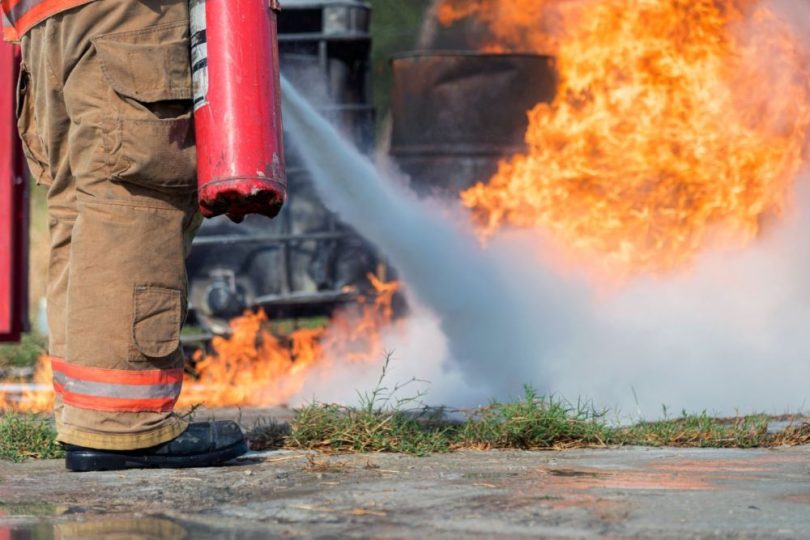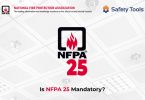Fire extinguishers used to control and extinguish Class A, B, and C fires release a fine, yellow powder that contains monoammonium phosphate. Since they are multipurpose extinguishers, this yellow color separates them from the non-multipurpose extinguishers.
On the other hand, for Class B and C fires, dry chemical extinguishers are used. They contain sodium bicarbonate (in other words – baking soda) that leaves a white powder after use.
If you end up making close contact with these yellow and white powders, you may have mild irritations on your skin, eyes, nose, and throat. You may also have headaches and dizziness.
What’s more, if you ingest or inhale the powder – whether deliberately or accidentally – there can be serious conditions like irregular heartbeat, kidney failure, pneumonia, and seizures.
Here’s the safest way to get rid of the powder.
How to Dispose of Fire Extinguisher Powder?
Precaution: You should wear a mask and have eye protection before you go about the process to avoid any health risk.
- If the extinguisher hasn’t been used before, you need to release the pressure inside first
- Slowly remove the valve to release the residual pressure and then detach the valve entirely
- Select a dumping site, dig a hole, dump the undischarged powder in a container or a bag, and refill it
- The chemicals are biodegradable and don’t pollute soil. They will decompose over time. These chemicals are
- Some fire extinguishers are rechargeable. If you have this type, you can refill the fire extinguisher to use it again
How to Clean up Fire Extinguisher Powder Residue?
1. Monoammonium phosphate residues
Monoammonium phosphate is the most common chemical element in fire extinguishers used to put out Class A,B, and C fires. You should use your hands to get rid of the residue because a vacuum cleaner would cause the chemicals to resuspend in the air.
Clean the residue by wet-sweeping with hot water and baking soda paste.
2. Sodium potassium and bicarbonate residues
Sodium potassium and bicarbonate are used to extinguish Class B and C fires. Their residues don’t cause any irritation or trouble, which allows you to clean them safely with a vacuum cleaner equipped with a HEPA filter.
But the most effective way to clean these chemical elements is by applying a solution with 98% hot water and 2% vinegar on the surface. Wait for a few minutes, then wipe off the area with a wet piece of cloth.
3. Class D powder residues
They are different types of dry chemical fire extinguishers used specially for flammable metal fires that may take place in industrial or laboratory settings.
The chemicals used in these fire extinguishers vary depending on types of metals found in the area where they will be used for protection. But they generally have one of these chemicals: sodium carbonate, sodium chloride, copper, or graphite.
While some of these powder residues can be cleaned easily, others (e.g. graphite powders) will require professional help. It is dangerous to use a vacuum as they are static-sensitive and can even be explosive if airborne.
Safety Always Comes First!
Fire extinguisher residues are not toxic but some may cause minor irritation to your eyes and skin, as stated before.
Always try to avoid direct contact with the residue by wearing hand gloves and clothes that cover your arms and legs.
Here’s what to do if you come into contact with these chemicals –
- If contacted with your skin, use soap and water
- If inhaled, go outside for fresh air or a well-ventilated room
- If exposed to eyes, flush your eyes with water until the irritation is gone
- If the irritation remains or you experience breathing issues, seek medical help
Wrapping it up
It is important to properly dispose of fire extinguisher powder to ensure safety and comply with local regulations. The specific method of disposal will depend on the type of powder and the regulations in your area.
Contact your local fire department or hazardous waste disposal facility to find out the specific regulations and procedures for disposing of fire extinguisher powder in your area.
If the powder is classified as hazardous waste, it will need to be transported to a facility that is equipped to handle and dispose of hazardous materials.
If the powder is not classified as hazardous waste, it may be possible to dispose of it in a landfill.
If the fire extinguisher has been used and the powder is contaminated with chemicals, it should be handled as hazardous waste and disposed of accordingly.









Leave a Comment